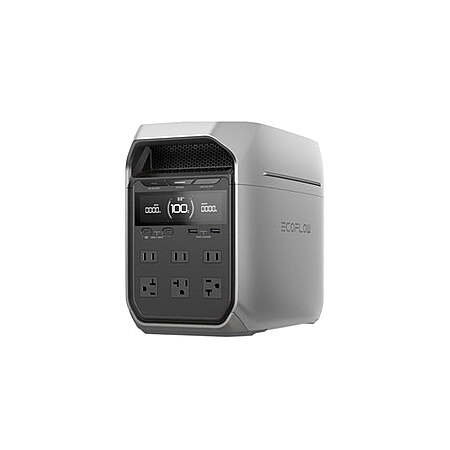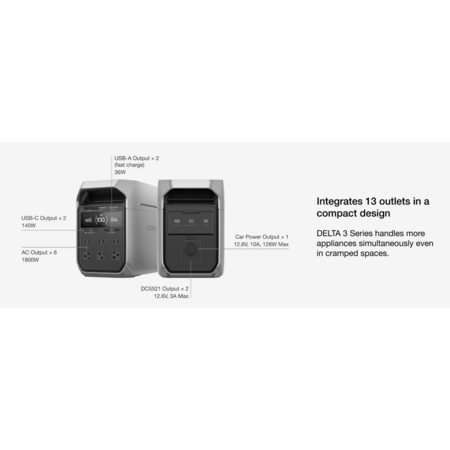Wellbots has
EcoFlow DELTA 3 Plus 1024Wh LiFePO4 Portable Power Station on sale for $629 - $94.35 w/ discount code
APRIL15 at checkout =
$534.65.
Shipping is free.
Thanks to Staff Member
the-press-box for sharing this deal.
About this Item:
- Dimensions: 15.7 x 8.3 x 11 in / 400 x 211 x 281 mm
- Net Weight (kg): ≤12.5kg
- Capacity: 1024 Wh
- 1-5kWh expandable with DELTA 3 Extra Battery, DELTA Pro 3 Extra Battery, DELTA 2 Extra Battery or DELTA 2 Max Extra Battery.
- Total Output Ports: 13
- AC Output: 6 outlets, 1800W total (Surge 3600W)
- Max Device(s) Power (with X-Boost): 2200W
- USB-A Output (Fast Charge): 2 ports, 36W Max
- USB-C Output: 2 ports, 140W Max
- Car Power Output: 1 port, 12.6V, 10A, 126W Max
- DC5521 Output: 2 ports, 12.6V, 3A Max
- AC Charging: 1500W
- Solar Charging: 2 ports, DC Charge Input, 11V-60V 500W Max
- Smart Generator Charging (1.8kW): 1500W
- Car Charging: 800W, in 1.3 Hour
- Battery Chemistry: LFP (LiFePO4 battery)
- Cycle Life: 4000 cycles to 80+% capacity
- Connectivity: APP (TOU / Storm Warning Alert)
- IP65
- UPS: <10ms
- Noise: 600W<30db; 1200W<40db
- Includes: 1x AC Charging Cable, 1x Car Charging Cable, 1x DC5521 to DC5525 Cable


Leave a Comment
Top Comments
the delta 3 plus is quieter.
the bluetti has only 4 (all of them grounded) ac outputs, while the ecoflow has six (only three grounded however, and three without the extra pin).
the ecoflow delta 3 plus has dual 140w usb-c ports, while the bluetti has only one 100w.
it's subjective, but most people are impressed with the ecoflow app, and the bluetti app is... meh.
once again, subjective, but i think the ecoflow styling on the delta 3 plus is more attractive than the bluetti. but to each his own. it makes no difference to me which one you buy.
p.s. i forgot, the ac 180 does have 1152 wh battery, while the delta 3 plus only 1024 wh.
so, the only reason to buy the refurb on ebay, is if you don't have to pay sales tax on ebay, or if you happen to live in a state where wellbots charges you tax.
so, yes, if you get charged sales tax by wellbots, then it would be cheaper to buy the refurb on ebay. for everyone who lives in a state which does not get taxed on wellbots, this is a far better deal.
the c1000 only has 600w dc/pv input, while this has 1000w (500w x 2).
the ecoflow has two 140w usb-c ports, the anker's are only 100w and 30w usb-c.
the delta 3 plus can charge with ac at 1500w vs. 1300w on the anker.
the delta 3 plus can do hybrid charging from both solar and ac at the same time. the anker can't do this.
the ecoflow is rated for 10ms ups, while the anker is 20ms.
the delta 3 plus battery is rated for 4,000 cycles, while the anker is rated for 3,000.
the delta 3 plus works with ecoflow's alternator charger, which is a great accessory. anker does not yet even offer an alternator charger.
most people consider the ecoflow app to be superior to anker's.
with regards to the delta 3 plus idle power usage, perhaps early on, with some pre-release or early units, i saw a couple reviews note the higher than normal self-consumption, but i believe this was addressed with a firmware upgrade. later reviewers show the idle consumption is not high or out of the ordinary.
i think i will do a test on mine, just to confirm.
i do like that the anker comes with a built-in light bar. i wish the ecoflow had that.
90 Comments
Sign up for a Slickdeals account to remove this ad.
you don't need to spend a bunch on solar to just power up a router and a laptop. you can charge your laptop or your phone by simply plugging it into your car (assuming you have one). might need to start the engine occasionally to make sure the battery is not drained.
and this delta 3 plus comes with a car cigarette lighter charging cable, which will give you around 100 watts charging into the power station, to keep your phone, laptop and router powered up.
if you require more than the 1 kwh battery that comes with this delta 3 plus, you can buy a 12v 100 Ah lifepo4 battery, with 1.28 kwh of capacity (25% more than this power station), for under $100 on a good sale. then you will need a $10 cord to attach to the battery with an xt60i connector on the other end, to feed the solar input of the delta 3 plus.
you should be able to run your internet router and keep your laptop charged up for the entire day, just with the built-in battery. with a $100 external battery, you should be able to go at least a couple of days.
depends on many factors, such as, do you need your modem/router on 24 hours a day, or do you plan to only power it when you are awake? you could unplug it when you go to bed, or when you are away running errands, etc.
they make larger ecoflow power stations which are much more suited to charging an ev. they have larger batteries, 240v output, and the power station can even be taken to an ev charging station and charged there (with the proper adapter cord) in an emergency, or while on the road. so, larger ecoflow power stations can both charge an ev, and also itself be charged at an ev station or from an ev, if you know some workarounds.
you can even charge this delta 3 plus from the large high-voltage battery pack --> 12v accessory battery --> delta 3 plus in an emergency, if you have the right equipment and know how. i think tesla claims it will void the warranty, but it still can be done. other manufacturers of ev's are often less hassle.
you have to use a coupon to get the alleged $219 price on ebay, and they tax the pre-coupon full price of $257.65, so you are actually paying extra sales tax. for me, it's a few dollars, so the price is more like $223 for me.
Pretty sure ecoflow is stacking up units in TX and CA to avoid higher tariffs so I expect these units to come down even more.
The point of my Ebay post was not to compare to Wellbots but point out, you should be buying refurbs from no-tax Wellbots where is where I get all my refurb ecoflow units which seems to be like new. Coming soon for 3+
Sign up for a Slickdeals account to remove this ad.
the c1000 only has 600w dc/pv input, while this has 1000w (500w x 2).
the ecoflow has two 140w usb-c ports, the anker's are only 100w and 30w usb-c.
the delta 3 plus can charge with ac at 1500w vs. 1300w on the anker.
the delta 3 plus can do hybrid charging from both solar and ac at the same time. the anker can't do this.
the ecoflow is rated for 10ms ups, while the anker is 20ms.
the delta 3 plus battery is rated for 4,000 cycles, while the anker is rated for 3,000.
the delta 3 plus works with ecoflow's alternator charger, which is a great accessory. anker does not yet even offer an alternator charger.
most people consider the ecoflow app to be superior to anker's.
with regards to the delta 3 plus idle power usage, perhaps early on, with some pre-release or early units, i saw a couple reviews note the higher than normal self-consumption, but i believe this was addressed with a firmware upgrade. later reviewers show the idle consumption is not high or out of the ordinary.
i think i will do a test on mine, just to confirm.
i do like that the anker comes with a built-in light bar. i wish the ecoflow had that.
Noise comparison: The Ecoflow 3 is pretty quiet, I'll give it that. For noise sensitive people this might actually be one of the more important areas of comparison. That being said, their isn't a drastic difference under normal use. The difference is really only noticeable until max load.
1000w vs 600w of solar input: 1000w solar input is pretty impressive, but it's overkill and mostly useless in a power station of this capacity. Most people aren't even going use half that. It's also limited to 60v per input, which is pretty crappy. You're going to be limited in your choice of solar panels and will end up running cables in parallel. 10awg wires running all over the place to limit loss, is again, silly and not practical in a mobile sized system. It's not like people are picking up a 1kw battery system to go off grid. Power stations of this size are meant for emergencies, camping, van life, or small jobs away from "shore" power. To get a 1000 watts of usable solar would require a lot of space and more than most mobile applications would have room for.
USB C Output: The higher output USB C ports are definitely a plus. But, you can easily add more via AC or 12v on the Anker since it's so much more efficient. I'd also add, that the Anker C1000X also has the lowest DC idle consumption I've seen out of all the 1kw size power stations.
Charging: 1500w vs 1400w (C1000X), not a huge difference in charge time, literally a few minutes.
Hybrid charging: I guess a plus, but also a niche feature that doesn't make a lot of sense in such a small capacity unit. System itself is still limited to the 1500w combined input when using both AC and DC. Makes sense when you have huge battery banks, but not so much with only 1kw of battery.
UPS @ 10ms vs 20ms. Both are kind of crappy and I wouldn't rely on either for any sensitive application that actually requires it. Get a line interactive or Online UPS.
Battery life: 4000 vs 3000 charge cycles. For all practical purposes the difference is fairly irrelevant as the batteries will deteriorate from calendar aging far before 99% of people even get close to either of these charge cycles.
Ecoflows DC 800w alternator charger is pretty cool. It's one of the faster DC to DC chargers if your vehicle's alternator can handle it. Problem is, it's proprietary, expensive and requires adapters to be used for different Ecoflow power stations. I bought the Pecron smart charger. It was $150 (Ecoflows is $350-$400+ on sale w/ adapters). I can also use the Pecron to charge any of my power stations with MC4 plugs. I have it attached to a 12v system using an XT90 plug, Only downside is it charges at closer to 500w (I haven't personally used the Ecoflow so I don't know if it can actually reach 800w). As a bonus, I can use the Pecron with all my 12v batteries (just by adding XT90s on them) to recharge different power stations via MC4 (increase capacity) It's not perfect since the cutoff voltage is around 12v and the efficiency loss, but as an emergency capacity boost it's nice.
App software: the Ecoflow is definitely better and gives choices for automation.
Obliviously, certain people will/can make it work for their specific purposes, but in general, that HUGE AC idle consumption turns what could have been a great power station, into a crappy one.
Sign up for a Slickdeals account to remove this ad.
Leave a Comment